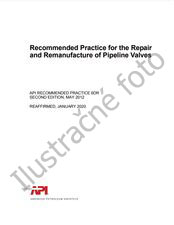Potrebujeme váš súhlas na využitie jednotlivých dát, aby sa vám okrem iného mohli ukazovať informácie týkajúce sa vašich záujmov. Súhlas udelíte kliknutím na tlačidlo „OK“.

API DR145-ed.2002
Identification of Oils that Produce Non-Buoyant in Situ Burning Residues and Methods for Their Recovery
NORMA vydaná dňa 1.2.2002
| Dostupnosť | Vypredané |
| Cena | NAOTÁZKU bez DPH |
| NA OTÁZKU |
Informácie o norme:
Označenie normy: API DR145-ed.2002
Dátum vydania normy: 1.2.2002
Kód tovaru: NS-1139357
Počet strán: 69
Približná hmotnosť: 207 g (0.46 libier)
Krajina: Americká technická norma
*) Pri tovare, ktorý nie je na sklade a musí sa objednávať u vydavateľa sa budú počítať aj skutočné náklady na dopravné a balné. Ich výšku Vám oznámime na základe vášho odkazu na e-mail info@normservis.sk, resp. na telefónnom čísle + 420 566 621 759.
Anotácia textu normy API DR145-ed.2002 :
API DR145, 2002 Edition, February 2002 - Identification of Oils that Produce Non-Buoyant in Situ Burning Residues and Methods for Their Recovery
INTRODUCTION
Research has established that the smoke plume from an oil spill in situ burning (ISB) operation will not pose a threat to persons if they are located more than about a mile or two downwind from the bum. This finding, among others, has led to advances in obtaining regulatory approval for burning. Now, another environmental concern has surfaced. This is the possible sinking of residues from in situ burns, leading to environmental damage at the sea bottom. Existing operational protocols do not consider this problem, and cleanup systems have not been developed and put in place to collect non-buoyant residues from ISB operations.
This "sinking" problem was not considered in the past because it had been observed in many in situ bum experiments that ISB residues, although dense and viscous, did not sink. Concerns started to develop in the early 1990s when two separate tanker spills involving heavy crude (the Haven and the Honam Jade) accidentally caught fire, burned, and produced large quantities of residue that did indeed sink. These observations suggested that the residues from the earlier experimental work did not sink because the starting oil involved relatively thin slicks and/or relatively light oils. Hindsight suggests that the more important factor was the relative thinness of the starting slick, which was usually on the order of one or two centimeters.
S.L. Ross examined the problem in a preliminary study completed for MSRC in 1995 entitled Laboratory Studies of the Properties of In situ Burn Residues (S.L. Ross, 1995). The study indicated that there is a large range of oils that may produce non-buoyant residues after an ISB operation involving thick slicks. Subsequently, in another S.L. Ross study completed for the U.S. Minerals Management Service (S.L. Ross, 1997), this was confirmed with a number of oils produced on the U.S. Outer Continental Shelf (OCS). Despite the small scale of the experiments, the results, which are discussed in detail later, suggest that non-buoyant residues may be produced more often than not in burn operations. There is thus a demand to develop a real-time capability to predict whether a particular oil and ISB operation will produce residues that sink. At the same time there is a need to develop appropriate countermeasures to deal with such residues.
Odporúčame:
Aktualizácia technických noriem
Chcete mať istotu, že používate len platné technické normy?
Ponúkame Vám riešenie, ktoré Vám zaistí mesačný prehľad o aktuálnosti noriem, ktoré používate.
Chcete vedieť viac informácií ? Pozrite sa na túto stránku.



 Cookies
Cookies
